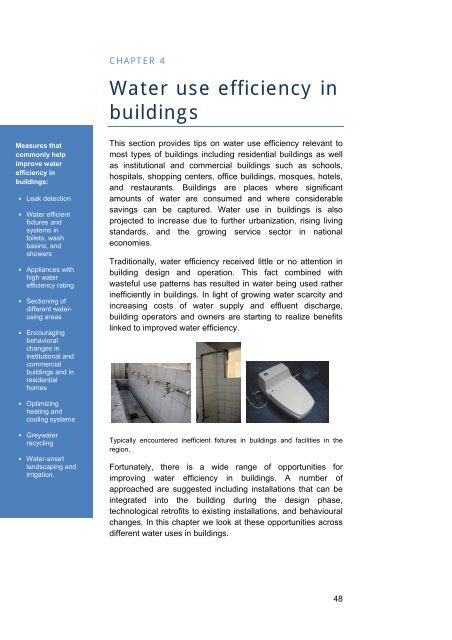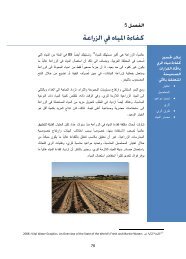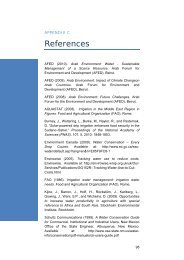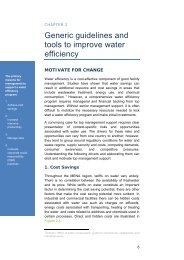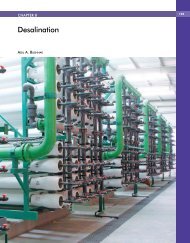Water use efficiency in buildings - Arab Forum for Environment and ...
Water use efficiency in buildings - Arab Forum for Environment and ...
Water use efficiency in buildings - Arab Forum for Environment and ...
Create successful ePaper yourself
Turn your PDF publications into a flip-book with our unique Google optimized e-Paper software.
CHAPTER 4<br />
<strong>Water</strong> <strong>use</strong> <strong>efficiency</strong> <strong>in</strong><br />
build<strong>in</strong>gs<br />
Measures that<br />
commonly help<br />
improve water<br />
<strong>efficiency</strong> <strong>in</strong><br />
build<strong>in</strong>gs:<br />
• Leak detection<br />
• <strong>Water</strong> efficient<br />
fixtures <strong>and</strong><br />
systems <strong>in</strong><br />
toilets, wash<br />
bas<strong>in</strong>s, <strong>and</strong><br />
showers<br />
• Appliances with<br />
high water<br />
<strong>efficiency</strong> rat<strong>in</strong>g<br />
• Section<strong>in</strong>g of<br />
different waterus<strong>in</strong>g<br />
areas<br />
• Encourag<strong>in</strong>g<br />
behavioral<br />
changes <strong>in</strong><br />
<strong>in</strong>stitutional <strong>and</strong><br />
commercial<br />
build<strong>in</strong>gs <strong>and</strong> <strong>in</strong><br />
residential<br />
homes<br />
This section provides tips on water <strong>use</strong> <strong>efficiency</strong> relevant to<br />
most types of build<strong>in</strong>gs <strong>in</strong>clud<strong>in</strong>g residential build<strong>in</strong>gs as well<br />
as <strong>in</strong>stitutional <strong>and</strong> commercial build<strong>in</strong>gs such as schools,<br />
hospitals, shopp<strong>in</strong>g centers, office build<strong>in</strong>gs, mosques, hotels,<br />
<strong>and</strong> restaurants. Build<strong>in</strong>gs are places where significant<br />
amounts of water are consumed <strong>and</strong> where considerable<br />
sav<strong>in</strong>gs can be captured. <strong>Water</strong> <strong>use</strong> <strong>in</strong> build<strong>in</strong>gs is also<br />
projected to <strong>in</strong>crease due to further urbanization, ris<strong>in</strong>g liv<strong>in</strong>g<br />
st<strong>and</strong>ards, <strong>and</strong> the grow<strong>in</strong>g service sector <strong>in</strong> national<br />
economies.<br />
Traditionally, water <strong>efficiency</strong> received little or no attention <strong>in</strong><br />
build<strong>in</strong>g design <strong>and</strong> operation. This fact comb<strong>in</strong>ed with<br />
wasteful <strong>use</strong> patterns has resulted <strong>in</strong> water be<strong>in</strong>g <strong>use</strong>d rather<br />
<strong>in</strong>efficiently <strong>in</strong> build<strong>in</strong>gs. In light of grow<strong>in</strong>g water scarcity <strong>and</strong><br />
<strong>in</strong>creas<strong>in</strong>g costs of water supply <strong>and</strong> effluent discharge,<br />
build<strong>in</strong>g operators <strong>and</strong> owners are start<strong>in</strong>g to realize benefits<br />
l<strong>in</strong>ked to improved water <strong>efficiency</strong>.<br />
• Optimiz<strong>in</strong>g<br />
heat<strong>in</strong>g <strong>and</strong><br />
cool<strong>in</strong>g systems<br />
• Greywater<br />
recycl<strong>in</strong>g<br />
• <strong>Water</strong>-smart<br />
l<strong>and</strong>scap<strong>in</strong>g <strong>and</strong><br />
irrigation.<br />
Typically encountered <strong>in</strong>efficient fixtures <strong>in</strong> build<strong>in</strong>gs <strong>and</strong> facilities <strong>in</strong> the<br />
region.<br />
Fortunately, there is a wide range of opportunities <strong>for</strong><br />
improv<strong>in</strong>g water <strong>efficiency</strong> <strong>in</strong> build<strong>in</strong>gs. A number of<br />
approached are suggested <strong>in</strong>clud<strong>in</strong>g <strong>in</strong>stallations that can be<br />
<strong>in</strong>tegrated <strong>in</strong>to the build<strong>in</strong>g dur<strong>in</strong>g the design phase,<br />
technological retrofits to exist<strong>in</strong>g <strong>in</strong>stallations, <strong>and</strong> behavioural<br />
changes. In this chapter we look at these opportunities across<br />
different water <strong>use</strong>s <strong>in</strong> build<strong>in</strong>gs.<br />
48
WATER USE BREAKDOWN IN<br />
BUILDINGS<br />
As would be familiar from our residential sett<strong>in</strong>gs, water <strong>in</strong><br />
build<strong>in</strong>gs is commonly <strong>use</strong>d <strong>for</strong> clean<strong>in</strong>g, <strong>for</strong> personal hygiene,<br />
<strong>for</strong> heat transfer, <strong>and</strong> <strong>for</strong> l<strong>and</strong>scap<strong>in</strong>g.<br />
Primary water <strong>use</strong> purposes <strong>in</strong> build<strong>in</strong>gs<br />
• Toilets<br />
• Showers<br />
• Wash bas<strong>in</strong>s<br />
• Kitchens<br />
• Laundry<br />
• Heat<strong>in</strong>g, ventilation, <strong>and</strong> air condition<strong>in</strong>g (HVAC) systems<br />
• L<strong>and</strong>scap<strong>in</strong>g.<br />
Although water–consum<strong>in</strong>g activities often rema<strong>in</strong> similar, the<br />
sophistication of water <strong>in</strong>frastructure as well as the quantities<br />
<strong>and</strong> <strong>use</strong> patterns can vary significantly depend<strong>in</strong>g on the<br />
primary purpose of the build<strong>in</strong>g. For example, while showers<br />
<strong>and</strong> toilets are particularly important <strong>in</strong> residences, schools,<br />
hotels, <strong>and</strong> office build<strong>in</strong>gs, HVAC systems <strong>and</strong> l<strong>and</strong>scap<strong>in</strong>g<br />
can be major <strong>use</strong>rs of water <strong>for</strong> shopp<strong>in</strong>g center <strong>and</strong> other<br />
large commercial <strong>and</strong> <strong>in</strong>stitutional build<strong>in</strong>gs.<br />
Figure 4.1: Typical water<br />
<strong>use</strong> breakdown <strong>in</strong> a<br />
residential build<strong>in</strong>g<br />
49
SYSTEMICALLY IMPROVING WATER<br />
EFFICIENCY IN BUILDINGS<br />
In order to improve water <strong>efficiency</strong> <strong>in</strong> build<strong>in</strong>gs, a systematic<br />
approach should be adopted, as outl<strong>in</strong>ed <strong>in</strong> Chapter 2.<br />
However, as mentioned earlier, build<strong>in</strong>gs can show significant<br />
differences <strong>in</strong> their water <strong>use</strong> characteristics <strong>and</strong> <strong>in</strong> the<br />
utilization of their water-related <strong>in</strong>frastructure. Build<strong>in</strong>gs also<br />
have different service life spans. A major difference can be<br />
observed between residential build<strong>in</strong>gs on one h<strong>and</strong> <strong>and</strong><br />
commercial <strong>and</strong> <strong>in</strong>stitutional build<strong>in</strong>gs on the other h<strong>and</strong>, <strong>in</strong><br />
terms of water systems complexity, the lifetime of fixtures <strong>and</strong><br />
equipments, <strong>and</strong> the resources <strong>and</strong> organisational capabilities<br />
of their owners, <strong>use</strong>rs, or operators. Consequently, monitor<strong>in</strong>g<br />
strategies <strong>and</strong> improvement options have to be adjusted <strong>and</strong><br />
tailored to these variations. This guide tries to rema<strong>in</strong><br />
cognizant of these differences.<br />
<strong>Water</strong> section<strong>in</strong>g system<br />
<strong>use</strong>d <strong>in</strong> a shopp<strong>in</strong>g center.<br />
PREPARATION AND PLANNING<br />
As <strong>in</strong> <strong>in</strong>dustrial facilities, water <strong>efficiency</strong> programs <strong>in</strong> build<strong>in</strong>gs<br />
require preparation <strong>and</strong> plann<strong>in</strong>g <strong>in</strong>clud<strong>in</strong>g conduct<strong>in</strong>g a facility<br />
survey, monitor<strong>in</strong>g <strong>use</strong>, determ<strong>in</strong><strong>in</strong>g per<strong>for</strong>mance targets,<br />
identify<strong>in</strong>g sav<strong>in</strong>g options, <strong>in</strong><strong>for</strong>m<strong>in</strong>g <strong>and</strong> engag<strong>in</strong>g build<strong>in</strong>g<br />
<strong>use</strong>rs, <strong>and</strong> allocat<strong>in</strong>g resources. In s<strong>in</strong>gle-family homes or<br />
apartments, the steps can be organised <strong>in</strong><strong>for</strong>mally <strong>and</strong> the<br />
process logic rema<strong>in</strong>s the same. In addition to the Data Form<br />
<strong>for</strong> Build<strong>in</strong>gs, provided as part of Support Sheet A <strong>in</strong> Chapter<br />
2, the follow<strong>in</strong>g checklist of questions can be helpful dur<strong>in</strong>g a<br />
site survey <strong>for</strong> an <strong>in</strong>stitutional or commercial build<strong>in</strong>g.<br />
50
CHECKLIST<br />
Plann<strong>in</strong>g questions <strong>in</strong> an <strong>in</strong>stitutional/commercial build<strong>in</strong>g site<br />
survey<br />
• How much water is consumed <strong>in</strong> different functions of the build<strong>in</strong>g<br />
• Which functions are the ma<strong>in</strong> consumers: HVAC, toilet facilities,<br />
technical areas, irrigation, others<br />
• What are the direct <strong>and</strong> <strong>in</strong>direct costs of water <strong>use</strong> <strong>in</strong> the build<strong>in</strong>g<br />
• What type of ma<strong>in</strong>tenance rout<strong>in</strong>es (such as leak <strong>in</strong>spections or<br />
equipment ma<strong>in</strong>tenance) are <strong>in</strong> place today<br />
• What water re<strong>use</strong> <strong>and</strong> recycl<strong>in</strong>g systems are <strong>in</strong> <strong>use</strong> or have been<br />
considered<br />
UNDERSTANDING WATER USE DYNAMICS<br />
Residential build<strong>in</strong>gs often have a relatively simple distribution<br />
structure with limited number of outlets <strong>and</strong> relatively lower<br />
consumption volumes. In these sett<strong>in</strong>gs, per<strong>for</strong>m<strong>in</strong>g a detailed<br />
monitor<strong>in</strong>g would neither be feasible nor necessary. An<br />
awareness of the overall water consumption of the build<strong>in</strong>g<br />
together with an average water <strong>use</strong> breakdown benchmark<br />
(Figure 4.1) would be sufficient to kick start an ef<strong>for</strong>t to identify<br />
water-sav<strong>in</strong>g opportunities.<br />
In commercial <strong>and</strong> <strong>in</strong>stitutional build<strong>in</strong>gs, the monitor<strong>in</strong>g<br />
activities will have to become more detailed to match the<br />
grow<strong>in</strong>g size <strong>and</strong> complexity of the water system. A more<br />
thorough <strong>and</strong> exhaustive ef<strong>for</strong>t is needed <strong>in</strong> order to develop a<br />
more <strong>use</strong>ful level of underst<strong>and</strong><strong>in</strong>g.<br />
CHECKLIST<br />
Required sub-meter<strong>in</strong>g <strong>in</strong> a shopp<strong>in</strong>g mall <strong>in</strong> order to develop<br />
sufficient underst<strong>and</strong><strong>in</strong>g of the water <strong>use</strong> dynamics<br />
• Cold water supply & hot water supply<br />
• Toilets <strong>and</strong> ur<strong>in</strong>als<br />
• Cool<strong>in</strong>g towers<br />
• Food courts <strong>and</strong> restaurants<br />
• Outdoor areas <strong>and</strong> water features<br />
• Retail shops<br />
• Sewage discharge.<br />
51
The next step after monitor<strong>in</strong>g is to<br />
develop water balances – <strong>for</strong> the<br />
entire build<strong>in</strong>g or <strong>for</strong> key water<br />
us<strong>in</strong>g activities – <strong>and</strong> usage<br />
patterns over time. Figure 4.2<br />
shows an example of water <strong>use</strong><br />
breakdown <strong>in</strong> a hotel.<br />
Figure 4.2: <strong>Water</strong> <strong>use</strong><br />
breakdown <strong>in</strong> a five-star hotel<br />
<strong>in</strong> Hong Kong.<br />
IDENTIFYING IMPROVEMENT OPTIONS<br />
Improvement measures need to be <strong>in</strong>vestigated with an eye on<br />
select<strong>in</strong>g from a set of areas or activities those that have the<br />
greatest potential <strong>for</strong> improvement. This will be a function of<br />
the type of build<strong>in</strong>g <strong>in</strong> question. Table 4.1 provides a summary<br />
of key areas <strong>for</strong> different build<strong>in</strong>g types.<br />
Areas with ma<strong>in</strong> improvement potential<br />
Build<strong>in</strong>g Type<br />
Toilets<br />
Showers<br />
S<strong>in</strong>ks<br />
Laundry<br />
Kitchen<br />
Heat<strong>in</strong>g/Cool<strong>in</strong>g<br />
L<strong>and</strong>scap<strong>in</strong>g<br />
Pools<br />
Sterilization<br />
Residential<br />
Hotels<br />
X X X<br />
X X X X X X X X<br />
Hospitals X X X X X X X<br />
Schools X X X X<br />
Offices X X X X<br />
Shopp<strong>in</strong>g centres X X X X X X<br />
Table 4.1: Areas of ma<strong>in</strong> improvement potential <strong>in</strong> different types of<br />
build<strong>in</strong>gs<br />
PRIORITISATION AND IMPLEMENTATION<br />
Once they are identified, the improvement possibilities need to<br />
be assessed based on their lifetime benefits <strong>and</strong> costs. For<br />
such assessments, knowledge of the true cost of water is<br />
52
needed. This step requires the quantification of both direct <strong>and</strong><br />
hidden costs, as described by the follow<strong>in</strong>g checklist.<br />
CHECKLIST<br />
Hidden water <strong>use</strong> costs <strong>in</strong> build<strong>in</strong>gs can often be l<strong>in</strong>ked to:<br />
• Costs <strong>for</strong> heat<strong>in</strong>g <strong>and</strong> cool<strong>in</strong>g the water<br />
• Pump<strong>in</strong>g costs <strong>for</strong> transport<strong>in</strong>g water<br />
• Treatment costs<br />
• Cost of chemicals.<br />
In addition to a benefit-cost analysis, the effect of identified<br />
options on the service quality, applicability, suitability, <strong>and</strong><br />
availability of support need to be assessed.<br />
Experience from European <strong>and</strong> North American countries<br />
shows that residential <strong>use</strong>rs are often better positioned to<br />
change water <strong>use</strong> patterns but may not have the resources <strong>for</strong><br />
detailed monitor<strong>in</strong>g or <strong>for</strong> replac<strong>in</strong>g exist<strong>in</strong>g fixtures or<br />
equipment with more efficient ones, thereby limit<strong>in</strong>g their<br />
options primarily to retrofits.<br />
ASSURING CONTINUATION<br />
One of the key virtues of a systematic water <strong>efficiency</strong> program<br />
is to assure that the process of improvement does not halt<br />
follow<strong>in</strong>g the first set of ga<strong>in</strong>s, but <strong>in</strong>stead becomes embedded<br />
as an <strong>in</strong>tegral part of normal rout<strong>in</strong>es. At a m<strong>in</strong>imum, this<br />
entails cont<strong>in</strong>uous monitor<strong>in</strong>g of water <strong>use</strong> patterns <strong>in</strong> key<br />
areas <strong>and</strong> tak<strong>in</strong>g corrective actions to h<strong>and</strong>le irregularities or to<br />
meet def<strong>in</strong>ed targets. It also <strong>in</strong>cludes cont<strong>in</strong>uously look<strong>in</strong>g <strong>for</strong><br />
new approaches that can reduce water consumption <strong>in</strong> the<br />
build<strong>in</strong>g <strong>and</strong> swiftly adopt<strong>in</strong>g those that prove to be feasible.<br />
53
COMMON WATER EFFICIENCY<br />
MEASURES FOR BUILDINGS<br />
There are numerous measures that can successfully improve<br />
water <strong>use</strong> <strong>efficiency</strong> <strong>in</strong> build<strong>in</strong>gs. The improvements can be<br />
achieved through a comb<strong>in</strong>ation of behavioral changes <strong>and</strong><br />
technological fixes. A description of some common measures<br />
follows.<br />
USE-BASED CHARGING<br />
A common problem h<strong>in</strong>der<strong>in</strong>g water <strong>efficiency</strong> improvements <strong>in</strong><br />
build<strong>in</strong>gs is l<strong>in</strong>ked to the tariff system. In many parts of the<br />
world, considerable segments of water <strong>use</strong>rs – whether they<br />
are ho<strong>use</strong> owners, occupants of flats <strong>in</strong> apartment build<strong>in</strong>gs, or<br />
tenants at a commercial center – are still not charged <strong>for</strong> water<br />
accord<strong>in</strong>g to their actual consumption. Instead, their water<br />
tariffs are based on a fixed cost, sometimes <strong>in</strong>corporated as<br />
part of a set monthly rent. This practice is a major hurdle to<br />
water <strong>efficiency</strong> beca<strong>use</strong> it removes <strong>in</strong>centives <strong>for</strong> lower<strong>in</strong>g<br />
water consumption. There<strong>for</strong>e, a key step <strong>in</strong> water <strong>efficiency</strong> <strong>in</strong><br />
build<strong>in</strong>gs requires <strong>in</strong>stall<strong>in</strong>g water meters <strong>for</strong> <strong>in</strong>dividual <strong>use</strong>rs<br />
<strong>and</strong> <strong>in</strong>troduc<strong>in</strong>g a fee account<strong>in</strong>g system based on actual<br />
consumption. The <strong>in</strong>centive <strong>for</strong> cost sav<strong>in</strong>gs can only be<br />
realised by mak<strong>in</strong>g water <strong>use</strong>rs aware of their consum<strong>in</strong>g<br />
habits <strong>and</strong> l<strong>in</strong>k<strong>in</strong>g their water bills to actual rates of<br />
consumption.<br />
DETECTING LEAKS<br />
<strong>Water</strong> leakage from toilets, faucets, or plumb<strong>in</strong>g fixtures can<br />
be responsible <strong>for</strong> as much as 10 to 30% of water losses. 1<br />
There<strong>for</strong>e, detect<strong>in</strong>g <strong>and</strong> repair<strong>in</strong>g leak<strong>in</strong>g fixtures <strong>for</strong>ms a<br />
good start<strong>in</strong>g po<strong>in</strong>t <strong>for</strong> <strong>efficiency</strong> improvements. By conduct<strong>in</strong>g<br />
regular checks <strong>and</strong> rout<strong>in</strong>e ma<strong>in</strong>tenance, considerable<br />
amounts of water can potentially be saved.<br />
Detect<strong>in</strong>g leaks <strong>in</strong> residential build<strong>in</strong>gs, where the number of<br />
outlets <strong>and</strong> water <strong>use</strong>rs is limited <strong>and</strong> concentrated, can be<br />
accomplished relatively easy as demonstrated by the tips box<br />
below. In commercial <strong>and</strong> <strong>in</strong>stitutional build<strong>in</strong>gs, more complex<br />
measures such as cont<strong>in</strong>uous monitor<strong>in</strong>g, overnight<br />
monitor<strong>in</strong>g, <strong>and</strong> water balances may need to be <strong>use</strong>d to<br />
determ<strong>in</strong>e the extent of leakage.<br />
1 <strong>Environment</strong> Canada. http://www.ec.gc.ca/eauwater/default.asplang=en&n=E85F9FC8-1<br />
<strong>and</strong> Sydney <strong>Water</strong>.<br />
54
TIPS<br />
Quick way to detect water leakage<br />
In order to verify whether your ho<strong>use</strong> is leak-free, read your water meter<br />
be<strong>for</strong>e <strong>and</strong> after a two-hour period when no water is be<strong>in</strong>g <strong>use</strong>d. If the meter<br />
does not read exactly the same, this <strong>in</strong>dicates the presence of leaks.<br />
Detect<strong>in</strong>g <strong>Water</strong> Leakage <strong>in</strong> Toilets<br />
Leaks with slow flows can be difficult to detect by ord<strong>in</strong>ary observation. To be<br />
sure, add some food-dye to the cistern. After 30 m<strong>in</strong>utes, check your toilet<br />
bowl <strong>for</strong> any color<strong>in</strong>g, which will <strong>in</strong>dicate leakage. Make sure to r<strong>in</strong>se the bowl<br />
to avoid permanent color<strong>in</strong>g.<br />
Once the magnitude of leakage is determ<strong>in</strong>ed, the leak<strong>in</strong>g<br />
fixture must be located <strong>and</strong> identified. A description of common<br />
leak<strong>in</strong>g areas or fixtures that are relatively easy to identify <strong>and</strong><br />
fix follows.<br />
Dripp<strong>in</strong>g taps, faucets, <strong>and</strong> shower heads<br />
A dripp<strong>in</strong>g tap can waste between 4,000 to 10,000 liters of<br />
water every year. This is enough water <strong>for</strong> 40 to 100 showers.<br />
Worn out plastic seals often ca<strong>use</strong> leakage <strong>in</strong> taps. Damaged<br />
seals can be easily <strong>and</strong> <strong>in</strong>expensively replaced, thereby sav<strong>in</strong>g<br />
thous<strong>and</strong>s of liters of water.<br />
Leakage <strong>in</strong> toilet flushes<br />
A toilet flush system that leaks water <strong>in</strong> the <strong>for</strong>m of a constant<br />
flow can result <strong>in</strong> the loss of substantial amounts of water.<br />
Leaks from toilets can also be harder to detect. Two of the<br />
problems that are common <strong>and</strong> that can be fixed relatively<br />
easily are:<br />
Components that can<br />
lead to leaks <strong>in</strong> a typical<br />
A misplaced or broken flap ca<strong>use</strong>s water to cont<strong>in</strong>uously<br />
flow <strong>in</strong>to the toilet bowl. A quick <strong>in</strong>spection of the flap<br />
mechanism to ensure that the flap is well–aligned with the<br />
flush-gate <strong>and</strong> that there are no obstructions can fix the<br />
problem. If the flap, or its seal, is damaged, it will need to be<br />
replaced.<br />
Cont<strong>in</strong>uous overflow happens when the shut-off level is not<br />
properly adjusted or when the movement of the float arm is<br />
obstructed. By adjust<strong>in</strong>g the shut-off level correctly <strong>and</strong> mak<strong>in</strong>g<br />
sure that the float arm moves freely, overflow can be avoided.<br />
55
Storage tanks<br />
In commercial <strong>and</strong> <strong>in</strong>stitutional build<strong>in</strong>gs, water supplied by the<br />
ma<strong>in</strong> is often stored <strong>in</strong> tanks prior to its <strong>use</strong>. The structural<br />
stability of storage tanks can deteriorate over time due to<br />
various reasons lead<strong>in</strong>g to leaks. This can be detected by<br />
monitor<strong>in</strong>g the water level <strong>in</strong> the tank dur<strong>in</strong>g a period when no<br />
water is be<strong>in</strong>g extracted from the tank. A drop <strong>in</strong> water level<br />
will <strong>in</strong>dicate leakage.<br />
Cool<strong>in</strong>g towers<br />
Overflow from cool<strong>in</strong>g tower bas<strong>in</strong>s, as covered <strong>in</strong> Chapter 3,<br />
can also be seen as a <strong>for</strong>m of leakage <strong>in</strong> <strong>in</strong>stitutional <strong>and</strong><br />
commercial build<strong>in</strong>gs <strong>and</strong> can lead to considerable wastage.<br />
Measures discussed earlier will also be applicable to build<strong>in</strong>gs.<br />
Pipes, jo<strong>in</strong>ts, <strong>and</strong> valves<br />
Old pipes, junctions, <strong>and</strong> valves with worn-out seal<strong>in</strong>g are<br />
potential sources of water losses <strong>in</strong> build<strong>in</strong>gs. These can be<br />
more difficult to detect, particularly if the leak<strong>in</strong>g water is<br />
f<strong>in</strong>d<strong>in</strong>g its way to effluent discharge channels. Leakage <strong>in</strong> the<br />
pip<strong>in</strong>g system may be <strong>in</strong>dicated if leakage persists after all the<br />
visible leakage po<strong>in</strong>ts have been repaired. In these cases,<br />
assistance from a professional may be necessary.<br />
TOILETS AND URINALS<br />
In many build<strong>in</strong>gs, toilets account <strong>for</strong> one-third of water <strong>use</strong>,<br />
mak<strong>in</strong>g them an attractive target <strong>for</strong> water <strong>efficiency</strong><br />
improvements. These can be achieved through behavioral<br />
changes, low cost retrofits, or replac<strong>in</strong>g older toilets with newer<br />
<strong>and</strong> more water-efficient models. In this section we present<br />
several of those options. It is important to exam<strong>in</strong>e closely the<br />
payback period when consider<strong>in</strong>g replacement options.<br />
56
Chang<strong>in</strong>g behavior<br />
Behavioral change towards avoid<strong>in</strong>g the <strong>use</strong> of toilet flush<br />
unnecessarily <strong>for</strong>ms a sensible start<strong>in</strong>g po<strong>in</strong>t <strong>for</strong> reduc<strong>in</strong>g<br />
water consumption <strong>in</strong> toilets. Users should be encouraged not<br />
to <strong>use</strong> the toilet as a garbage b<strong>in</strong> <strong>and</strong> not to dispose of, <strong>for</strong><br />
example, tissues, dead <strong>in</strong>sects, or similar waste. In private<br />
homes such changes can be relatively easy to implement. In<br />
<strong>in</strong>stitutional <strong>and</strong> commercial build<strong>in</strong>gs, on the other h<strong>and</strong>, more<br />
<strong>for</strong>mal tra<strong>in</strong><strong>in</strong>g as well as the <strong>use</strong> of educational signs may be<br />
necessary to stimulate a change <strong>in</strong> <strong>use</strong>r behavior.<br />
Volume displacement objects<br />
A volume<br />
displacement object<br />
cansaveupto30%<br />
If the toilet is of an older model, a simple <strong>and</strong> effective<br />
measure to conserve water is to place a displacement object<br />
<strong>in</strong>side the toilet cistern. These are objects that sit <strong>in</strong>side the<br />
cistern permanently occupy<strong>in</strong>g a reasonable volume without<br />
<strong>in</strong>terfer<strong>in</strong>g with the operational mechanism of the flush system.<br />
Plastic bottles filled with water <strong>and</strong> carefully placed <strong>in</strong>side the<br />
cistern can serve this purpose. There are also commercial<br />
products that can be <strong>use</strong>d as cistern displacement. Another<br />
possibility is to <strong>use</strong> the so-called toilet dams. These are<br />
barriers placed <strong>in</strong>side the cistern, creat<strong>in</strong>g dry compartments<br />
<strong>and</strong> thereby reduc<strong>in</strong>g the amount of water <strong>use</strong>d <strong>in</strong> each flush.<br />
These devices can save 1 to 3 liters of water per flush.<br />
Low-volume or dual-mode flush systems<br />
While conventional flush systems <strong>use</strong> more than 11 liters of<br />
water per flush, modern low-volume, dual-mode flush systems<br />
can reduce this amount to 4.5 liters per full flush <strong>and</strong> 3 liters<br />
per partial flush. Such a conversion may translate <strong>in</strong>to<br />
57<br />
A dual-mode flush<br />
system.
thous<strong>and</strong>s of liters of water be<strong>in</strong>g saved annually. However,<br />
these systems usually require the replacement of not only the<br />
cistern <strong>and</strong> the flush<strong>in</strong>g mechanism, but also the toilet bowl.<br />
There<strong>for</strong>e, they should be considered when replac<strong>in</strong>g old<br />
models or <strong>in</strong>stall<strong>in</strong>g new toilets. It should also be noted that<br />
low-flow toilets are more prone to clogg<strong>in</strong>g <strong>and</strong> may require the<br />
elim<strong>in</strong>ation of certa<strong>in</strong> grades of toilet paper.<br />
Vacuum-toilets<br />
Toilets can be connected to a vacuum source to employ <strong>for</strong><br />
flush<strong>in</strong>g. These systems operate with the help of a pump that<br />
creates a vacuum to help flush the contents of a toilet with<br />
m<strong>in</strong>imal water <strong>use</strong>. With such systems water consumption<br />
can be reduced to as low as 0.5 liters per flush.<br />
Compost<strong>in</strong>g toilets<br />
A compost<strong>in</strong>g toilet.<br />
More suited to rural areas, these toilets elim<strong>in</strong>ate the <strong>use</strong> of<br />
water <strong>and</strong> do not create black effluents. If properly managed,<br />
they can also produce sterile humus that is free from<br />
unwanted smells. These units have, however, larger space<br />
requirements <strong>and</strong> dem<strong>and</strong> appropriate h<strong>and</strong>l<strong>in</strong>g from <strong>use</strong>rs.<br />
URINALS<br />
Ur<strong>in</strong>als are often <strong>use</strong>d <strong>in</strong> public amenities <strong>and</strong> are<br />
conventionally fitted with cyclic flush<strong>in</strong>g systems. Beca<strong>use</strong> they<br />
waste considerable amount of water, their <strong>use</strong> should be<br />
elim<strong>in</strong>ated. The follow<strong>in</strong>g are examples of more efficient<br />
alternatives.<br />
Ur<strong>in</strong>als with on-dem<strong>and</strong> sensors<br />
Infrared sensor operated ur<strong>in</strong>als work by detect<strong>in</strong>g the<br />
presence of a <strong>use</strong>r with<strong>in</strong> the detection zone <strong>for</strong> more than a<br />
certa<strong>in</strong> time threshold. The <strong>use</strong>r’s departure from the detection<br />
zone activates flush<strong>in</strong>g. These units <strong>use</strong> no more than 1 to 1.5<br />
litres of water per flush. Such sensor can be prone to<br />
malfunction<strong>in</strong>g lead<strong>in</strong>g to water wastage. It is there<strong>for</strong>e<br />
important to fit them with manual shut off valves. The cont<strong>in</strong>ual<br />
monitor<strong>in</strong>g <strong>and</strong> ma<strong>in</strong>tenance of the sensors is also essential<br />
<strong>for</strong> susta<strong>in</strong>ed <strong>efficiency</strong>.<br />
<strong>Water</strong>less ur<strong>in</strong>als<br />
<strong>Water</strong>less ur<strong>in</strong>als have a dra<strong>in</strong> trap <strong>in</strong>sert siphon that collects<br />
the ur<strong>in</strong>e <strong>and</strong> discharges it <strong>in</strong>to the sewage system, without<br />
Example of a<br />
waterless ur<strong>in</strong>al.<br />
58
us<strong>in</strong>g water. These ur<strong>in</strong>als have hydrophobic <strong>in</strong>ner surface <strong>and</strong><br />
are also equipped with a hydrostatic float, which seals the<br />
discharge open<strong>in</strong>g of the ur<strong>in</strong>al <strong>and</strong> does not allow smells to be<br />
released.<br />
Use of greywater <strong>in</strong> flush<strong>in</strong>g<br />
Alternative sources of water can be <strong>use</strong>d to flush toilets <strong>and</strong><br />
ur<strong>in</strong>als. In particular, water consumed <strong>in</strong> showers, wash<br />
bas<strong>in</strong>s, <strong>and</strong> laundry operations – so-called greywater – can be<br />
re<strong>use</strong>d. Greywater re<strong>use</strong> <strong>in</strong> toilets, however, requires the<br />
<strong>in</strong>stallation of extra pipes, pumps, a storage unit, <strong>and</strong> a simple<br />
treatment unit. It can be costly to retrofit exist<strong>in</strong>g toilets <strong>and</strong><br />
ur<strong>in</strong>als with a greywater collection system. It is much more<br />
feasible to <strong>in</strong>troduce a system <strong>for</strong> collect<strong>in</strong>g <strong>and</strong> treat<strong>in</strong>g<br />
grewater <strong>for</strong> re<strong>use</strong> dur<strong>in</strong>g the design phase.<br />
The Aqua <br />
The Aqua catches the water flow<strong>in</strong>g down your s<strong>in</strong>k<br />
dra<strong>in</strong>. The collected water is filtered, dis<strong>in</strong>fected, <strong>and</strong><br />
stored to ready it <strong>for</strong> the next toilet flush. The system<br />
is designed to be easily retrofitted <strong>in</strong>to exist<strong>in</strong>g fixtures<br />
<strong>and</strong> boasts low ma<strong>in</strong>tenance. A small electric pump<br />
transports the water from the 21-liter (5.5 gallon)<br />
hold<strong>in</strong>g tank <strong>in</strong>stalled under the s<strong>in</strong>k. A device <strong>in</strong> the<br />
toilet tank prevents fresh water <strong>in</strong>flow as long as<br />
sufficient water is available <strong>in</strong> the Aqua to do the job.<br />
Source: www.thetreehugger.com<br />
BATHS AND SHOWERS<br />
Baths <strong>and</strong> showers can account <strong>for</strong> up to 30% of total<br />
domestic water <strong>use</strong>. Through a comb<strong>in</strong>ation of behavioral <strong>and</strong><br />
technical approaches, up to 50% reduction <strong>in</strong> water <strong>use</strong> can be<br />
achieved <strong>in</strong> baths <strong>and</strong> showers without compromis<strong>in</strong>g hygiene<br />
or com<strong>for</strong>t requirements.<br />
Giv<strong>in</strong>g a preference to showers over baths<br />
Mak<strong>in</strong>g changes <strong>in</strong> usage patterns is aga<strong>in</strong> one of the most<br />
effective ways of improv<strong>in</strong>g water <strong>efficiency</strong> <strong>in</strong> baths <strong>and</strong><br />
showers. Naturally, when baths can be <strong>use</strong>d <strong>for</strong> therapeutic<br />
<strong>and</strong> relaxation purposes, they can be difficult to substitute.<br />
However, when the purpose is solely personal hygiene,<br />
showers should be preferred over baths. Showers not only <strong>use</strong><br />
59
less water – provided that they are reasonably short – but also<br />
offer better hygienic results.<br />
Controll<strong>in</strong>g water flow <strong>and</strong> time <strong>in</strong> showers<br />
Example of a<br />
shower timer.<br />
Stay<strong>in</strong>g under runn<strong>in</strong>g water can be tempt<strong>in</strong>g but results <strong>in</strong><br />
wasteful <strong>use</strong> of water. By reduc<strong>in</strong>g the average length of a<br />
shower by two m<strong>in</strong>utes, a family of four can save up to 60 m 3<br />
of water <strong>in</strong> a year. Simple <strong>and</strong> <strong>in</strong>expensive timers are available<br />
to alert <strong>use</strong>rs of the time spent <strong>in</strong> a shower. In an ord<strong>in</strong>ary<br />
shower cycle, as much as 50% sav<strong>in</strong>gs can be achieved by<br />
turn<strong>in</strong>g the water off while shampoo<strong>in</strong>g your hair or wash<strong>in</strong>g<br />
your body.<br />
Tips<br />
Implement<strong>in</strong>g behavioral changes can be easier <strong>in</strong> residential homes than, <strong>for</strong><br />
<strong>in</strong>stance, <strong>in</strong> hotels, where excessive water <strong>use</strong> <strong>in</strong> showers <strong>and</strong> baths can be<br />
seen as part of an exclusive service offer<strong>in</strong>g. To trigger changes among hotel<br />
guests, awareness rais<strong>in</strong>g us<strong>in</strong>g leaflets <strong>and</strong> <strong>in</strong><strong>for</strong>mational campaigns can be<br />
l<strong>in</strong>ked to the social responsibility mission associated with a hotel br<strong>and</strong>.<br />
<strong>Water</strong> efficient shower heads<br />
Efficient shower heads operate by mix<strong>in</strong>g water flow with an air<br />
jet. These units provide satisfactory contact with water <strong>and</strong><br />
achieve effective r<strong>in</strong>s<strong>in</strong>g with much less water. Whereas a fivem<strong>in</strong>ute<br />
shower with a normal shower head can <strong>use</strong> around 100<br />
liters of water, a water efficient shower head consumes a<br />
modest 35 liters.<br />
Showers with automatic shut-off systems<br />
Showers with shut-off systems automatically cut the water flow<br />
once a predeterm<strong>in</strong>ed amount of water has been <strong>use</strong>d <strong>and</strong><br />
require <strong>use</strong>r <strong>in</strong>put to re-activate the water flow. Such systems<br />
are particularly well-suited <strong>for</strong> schools, offices, <strong>and</strong> sports<br />
facilities but their <strong>use</strong> is also becom<strong>in</strong>g common <strong>in</strong> motels <strong>and</strong><br />
guest ho<strong>use</strong>s.<br />
Example of a shower<br />
head with an air jet.<br />
Source:<br />
www.showerheadstor.com<br />
Use of easily adjustable mixers<br />
More than 10% of the total amount of water <strong>use</strong>d <strong>in</strong> a shower<br />
cycle can be wasted while try<strong>in</strong>g to adjust <strong>for</strong> a com<strong>for</strong>table<br />
temperature. With the <strong>use</strong> of easily adjustable water mixers<br />
with temperature <strong>in</strong>dicators, desired water temperatures can<br />
be more easily achieved, thereby wast<strong>in</strong>g less water.<br />
60
<strong>Water</strong> <strong>use</strong>d <strong>in</strong> showers <strong>and</strong> baths can be suitable <strong>for</strong><br />
alternative <strong>use</strong>s. There<strong>for</strong>e, <strong>in</strong>stead of lett<strong>in</strong>g it dra<strong>in</strong>, it can be<br />
captured, treated, <strong>and</strong> re<strong>use</strong>d (see section on greywater <strong>use</strong>).<br />
FAUCETS, TAPS, AND WASH BASINS<br />
<strong>Water</strong> <strong>efficiency</strong> <strong>in</strong> these areas can also start with some<br />
behavioral changes, such as not lett<strong>in</strong>g the water run straight<br />
to the dra<strong>in</strong> while teeth brush<strong>in</strong>g, h<strong>and</strong>-wash<strong>in</strong>g, or shav<strong>in</strong>g.<br />
Wash<strong>in</strong>g razor blades <strong>in</strong> a conta<strong>in</strong>er with hot water <strong>in</strong>stead of<br />
under runn<strong>in</strong>g water can also improve water <strong>efficiency</strong>. With<br />
regards to technical <strong>in</strong>stallations, the follow<strong>in</strong>g options should<br />
be considered.<br />
<strong>Water</strong> efficient faucets <strong>and</strong> tap adaptors<br />
Simple devices that mix water <strong>and</strong> air can reduce both water<br />
flow rates <strong>and</strong> splash<strong>in</strong>g while <strong>in</strong>creas<strong>in</strong>g areas of coverage<br />
<strong>and</strong> wett<strong>in</strong>g <strong>efficiency</strong>. For example, faucet aerators can save<br />
water <strong>use</strong> by up to 50% dur<strong>in</strong>g h<strong>and</strong>-wash<strong>in</strong>g. Modern faucets<br />
come with <strong>in</strong>tegrated aerators <strong>and</strong> should be preferred <strong>for</strong> new<br />
<strong>in</strong>stallations. Effective aerat<strong>in</strong>g adaptors are also available<br />
<strong>in</strong>expensively <strong>and</strong> can be easily <strong>in</strong>stalled.<br />
Faucets with on-dem<strong>and</strong> sensors<br />
A tap with an <strong>in</strong>frared<br />
on-dem<strong>and</strong> sensor.<br />
On-dem<strong>and</strong> faucet units rely on <strong>in</strong>frared sensors to trigger<br />
water flow. With the <strong>use</strong> of such systems, water <strong>use</strong> <strong>in</strong> wash<br />
bas<strong>in</strong>s can be reduced considerably. It is essential that such<br />
units have a quick response time <strong>in</strong> order to avoid <strong>use</strong>r<br />
dissatisfaction. In addition, such units provide improved results<br />
if <strong>use</strong>d <strong>in</strong> comb<strong>in</strong>ation with aerators (see above).<br />
Faucets with automatic shut-off systems<br />
Faucets with automatic shut-off systems will cut the flow of<br />
water once a predeterm<strong>in</strong>ed amount of water has been<br />
discharged. These units can <strong>use</strong> mechanical triggers or<br />
<strong>in</strong>frared sensors to control water flow. These units need to be<br />
<strong>use</strong>d <strong>in</strong> comb<strong>in</strong>ation with water sav<strong>in</strong>g aerators. In cases<br />
where the shut-off limit is not properly matched to the needs of<br />
the <strong>use</strong>rs, these units may result <strong>in</strong> wasteful <strong>use</strong> of water.<br />
Figure 4.3 depicts how water consumption varies with different<br />
types of faucets.<br />
Easy to fit <strong>and</strong><br />
<strong>in</strong>expensive, aerators<br />
can save water by up<br />
A push-button automatic<br />
shut-off tap system.<br />
61
Figure 4.3: <strong>Water</strong> consumption <strong>and</strong> sav<strong>in</strong>gs us<strong>in</strong>g different types of<br />
faucets<br />
LAUNDRIES<br />
Laundry operations are another high water-<strong>use</strong> area,<br />
especially <strong>for</strong> homes, hospitals, hotels, <strong>and</strong> commercial l<strong>in</strong>en<br />
services.<br />
For residential homes, clothes mach<strong>in</strong>e wash<strong>in</strong>g is much more<br />
water efficient than do<strong>in</strong>g laundry by h<strong>and</strong>. Consequently, <strong>use</strong><br />
of wash<strong>in</strong>g mach<strong>in</strong>es should be prioritized. In addition, frontload<strong>in</strong>g<br />
wash<strong>in</strong>g mach<strong>in</strong>es with high <strong>efficiency</strong> rat<strong>in</strong>gs should<br />
be selected when outfitt<strong>in</strong>g new build<strong>in</strong>gs or replac<strong>in</strong>g old<br />
equipment.<br />
Behavioral approaches can have a significant impact on water<br />
<strong>use</strong> <strong>in</strong> laundry operations. For example, laundry cycles should<br />
be adjusted so that wash<strong>in</strong>g mach<strong>in</strong>es are run at full loads<br />
rather than partial loads.<br />
Overall water consumption <strong>in</strong> laundry <strong>for</strong> a given sett<strong>in</strong>g can<br />
also be reduced significantly by per<strong>for</strong>m<strong>in</strong>g the wash<strong>in</strong>g when<br />
it is necessary rather than accord<strong>in</strong>g to a pre-set schedule.<br />
This is particularly relevant <strong>in</strong> hotels where traditionally all<br />
towels <strong>and</strong> bed sheets are replaced <strong>and</strong> laundered on a daily<br />
basis. An <strong>in</strong>creas<strong>in</strong>g number of hotels today allow their<br />
customers to decide if they want their towels <strong>and</strong> sheets<br />
replaced, thereby elim<strong>in</strong>at<strong>in</strong>g unnecessary laundry.<br />
Greywater from laundry operations can be subjected to basic<br />
treatment <strong>and</strong> made suitable <strong>for</strong> re<strong>use</strong>. It can be re<strong>use</strong>d to<br />
flush toilets. It can also be <strong>use</strong>d <strong>for</strong> outdoor irrigation.<br />
<strong>Water</strong>-rat<strong>in</strong>g labels help<br />
consumers choose more<br />
efficient wash<strong>in</strong>g<br />
mach<strong>in</strong>es. Source: <strong>Water</strong><br />
Efficiency Label<strong>in</strong>g <strong>and</strong><br />
St<strong>and</strong>ards, Australia.<br />
62
There<strong>for</strong>e, plans to capture <strong>and</strong> re<strong>use</strong> greywater from laundry<br />
operations should be considered dur<strong>in</strong>g the design phase of<br />
new build<strong>in</strong>gs.<br />
KITCHENS<br />
Kitchens <strong>in</strong> different sett<strong>in</strong>gs are another high-water <strong>use</strong> area,<br />
particularly <strong>in</strong> commercial <strong>and</strong> <strong>in</strong>stitutional build<strong>in</strong>gs, such as<br />
hotels, schools, restaurants, <strong>and</strong> shopp<strong>in</strong>g centres. Once<br />
aga<strong>in</strong>, with a comb<strong>in</strong>ation of behavioral <strong>and</strong> technical changes,<br />
water <strong>use</strong> <strong>in</strong> the kitchens can be reduced considerably.<br />
Elim<strong>in</strong>ate us<strong>in</strong>g runn<strong>in</strong>g water <strong>for</strong> food<br />
preparation<br />
Both <strong>in</strong> domestic <strong>and</strong> commercial kitchens vegetables <strong>and</strong><br />
fruits need to be washed prior to be<strong>in</strong>g <strong>use</strong>d <strong>in</strong> food<br />
preparation. Instead of wash<strong>in</strong>g under runn<strong>in</strong>g water, us<strong>in</strong>g a<br />
water conta<strong>in</strong>er can be equally effective. Additionally, avoid<br />
us<strong>in</strong>g runn<strong>in</strong>g water <strong>for</strong> defrost<strong>in</strong>g. This practice wastes large<br />
quantities of water. Instead, defrost<strong>in</strong>g can be achieved by<br />
plac<strong>in</strong>g frozen food items <strong>in</strong> a refrigerator or <strong>in</strong> a room<br />
environment <strong>for</strong> a reasonable amount of time (beware of time<br />
to avoid food spoilage). Microwave ovens can also be <strong>use</strong>d <strong>for</strong><br />
defrost<strong>in</strong>g.<br />
Us<strong>in</strong>g a dishwasher<br />
Whenever possible, dishes <strong>and</strong> utensils should be washed<br />
us<strong>in</strong>g dishwash<strong>in</strong>g mach<strong>in</strong>es beca<strong>use</strong> they are far more water<br />
efficient than manual wash<strong>in</strong>g. For commercial applications,<br />
<strong>and</strong> also <strong>for</strong> ho<strong>use</strong>holds, preference should be given to<br />
mach<strong>in</strong>es that have higher water <strong>efficiency</strong>. Such dishwashers<br />
should be run once fully loaded, rather than at partial loads. It<br />
should be noted that modern domestic dishwashers that utilize<br />
63
high-pressure steam can easily h<strong>and</strong>le a great majority of the<br />
dirt found on dishes <strong>and</strong> DO NOT require pre-r<strong>in</strong>s<strong>in</strong>g.<br />
Mechanical pre-r<strong>in</strong>se <strong>for</strong> manual wash<strong>in</strong>g<br />
Where manual wash<strong>in</strong>g is the only option, priority should be<br />
given to remov<strong>in</strong>g food residues from dishes by mechanical<br />
means, such as with the help of a <strong>use</strong>d napk<strong>in</strong> or a brush, over<br />
us<strong>in</strong>g runn<strong>in</strong>g water. If necessary, dishes could be soaked <strong>in</strong> a<br />
conta<strong>in</strong>er to allow the residues to soften. Actual wash<strong>in</strong>g <strong>and</strong><br />
r<strong>in</strong>s<strong>in</strong>g should also be per<strong>for</strong>med us<strong>in</strong>g batches of water<br />
placed <strong>in</strong> conta<strong>in</strong>ers <strong>in</strong>stead of runn<strong>in</strong>g water.<br />
Triggered spray nozzles<br />
In commercial kitchens, pre-r<strong>in</strong>s<strong>in</strong>g of the dishes is common <strong>in</strong><br />
order to reduce water <strong>and</strong> chemical consumption <strong>in</strong> quick-cycle<br />
dishwashers. In such activities, <strong>use</strong> of high-pressure nozzles<br />
with a h<strong>and</strong>-held trigger can result <strong>in</strong> substantial water sav<strong>in</strong>gs.<br />
Use of hot water<br />
A tap with a triggered<br />
spray nozzle can save a<br />
lot of water <strong>in</strong> kitchens.<br />
Picture: Superb Lifestyle<br />
products.<br />
Hot water is much more effective <strong>in</strong> remov<strong>in</strong>g food rema<strong>in</strong>s<br />
from dishes <strong>and</strong> there<strong>for</strong>e provides equal or better clean<strong>in</strong>g<br />
with much lower volumes than cold water. However, the<br />
energy costs of water heat<strong>in</strong>g need to be taken <strong>in</strong>to<br />
consideration.<br />
Ice makers<br />
Commonly found <strong>in</strong> restaurants <strong>and</strong> hotels, ice makers can<br />
<strong>use</strong> considerable amounts of water. Air cooled mach<strong>in</strong>es,<br />
which require only about 1.9 liters of water per kilogram of ice,<br />
should be preferred over water cooled mach<strong>in</strong>es, which may<br />
<strong>use</strong> as high as seven times more water.<br />
Space clean<strong>in</strong>g<br />
Commercial kitchens need to be frequently cleaned <strong>for</strong><br />
hygienic purposes. A number of measures can be adopted to<br />
reduce water <strong>use</strong>. Section<strong>in</strong>g the areas accord<strong>in</strong>g to clean<strong>in</strong>g<br />
needs, utiliz<strong>in</strong>g mechanical clean<strong>in</strong>g to the extent possible, <strong>and</strong><br />
us<strong>in</strong>g high-pressure, low-volume systems can collectively help<br />
reduce water consumption <strong>for</strong> space clean<strong>in</strong>g.<br />
64
LANDSCAPING<br />
<strong>Water</strong> <strong>use</strong> <strong>for</strong> l<strong>and</strong>scap<strong>in</strong>g can consume considerable amounts<br />
of water <strong>and</strong> usually holds a good potential <strong>for</strong> <strong>efficiency</strong> ga<strong>in</strong>s.<br />
Three ma<strong>in</strong> approaches are effective <strong>in</strong> reduc<strong>in</strong>g the amount of<br />
water <strong>use</strong>d <strong>in</strong> l<strong>and</strong>scap<strong>in</strong>g:<br />
Select<strong>in</strong>g the right plant species<br />
Plant species hold the most important promise <strong>for</strong> reduc<strong>in</strong>g<br />
water consumption. Un<strong>for</strong>tunately, exotic plant species that are<br />
not native to the local environment are commonly <strong>use</strong>d <strong>in</strong><br />
gardens, which dem<strong>and</strong> excessive quantities of water <strong>and</strong><br />
additional ma<strong>in</strong>tenance. In semi-arid areas, characteristic of<br />
most MENA countries, drought-tolerant varieties should be the<br />
preferred option. Drought-tolerant plants are an essential part<br />
of water efficient l<strong>and</strong>scapes. They are adapted to waterscarce<br />
environments <strong>and</strong> there<strong>for</strong>e require m<strong>in</strong>imal<br />
supplemental irrigation. They also require less ma<strong>in</strong>tenance<br />
than their water-needy counterparts.<br />
<strong>Water</strong> conserv<strong>in</strong>g l<strong>and</strong>scapes project <strong>in</strong> Jordan<br />
The Center <strong>for</strong> the Study of the Built <strong>Environment</strong> (CSBE) project on water<br />
conserv<strong>in</strong>g l<strong>and</strong>scapes is concerned with the development of aesthetically<br />
pleas<strong>in</strong>g l<strong>and</strong>scapes that also conserve the <strong>use</strong> of water. These goals are<br />
achieved through a variety of means, which <strong>in</strong>clude us<strong>in</strong>g native <strong>and</strong> droughttolerant<br />
vegetation, mak<strong>in</strong>g maximum <strong>use</strong> of ra<strong>in</strong>fall runoff, <strong>and</strong> <strong>in</strong>corporat<strong>in</strong>g<br />
hard-covered ground surfaces (consist<strong>in</strong>g of materials such as pebbles,<br />
stones, bricks, <strong>and</strong> concrete) <strong>in</strong> l<strong>and</strong>scape designs, rather than rely<strong>in</strong>g<br />
exclusively on surfaces covered with vegetation.<br />
The project generates <strong>in</strong><strong>for</strong>mative educational leaflets <strong>and</strong> manuals <strong>in</strong> both<br />
<strong>Arab</strong>ic <strong>and</strong> English on water conserv<strong>in</strong>g l<strong>and</strong>scapes, featur<strong>in</strong>g a list of<br />
drought-tolerant plants adapted to the region. Available <strong>for</strong> free at:<br />
Optimization of irrigation systems<br />
Irrigation can be per<strong>for</strong>med by h<strong>and</strong> or through a dedicated<br />
<strong>in</strong>stallation. When choos<strong>in</strong>g an irrigation set-up, below ground<br />
irrigation systems should be prioritized over above ground<br />
systems, thus m<strong>in</strong>imiz<strong>in</strong>g evaporation losses. In addition,<br />
synchroniz<strong>in</strong>g irrigation to changes <strong>in</strong> soil moisture content is<br />
more efficient than rely<strong>in</strong>g on pre-set frequencies. When<br />
managed properly, an automatic irrigation controller can pay<br />
<strong>for</strong> itself <strong>in</strong> reduced water usage, cost, <strong>and</strong> labour. By us<strong>in</strong>g a<br />
simple device to monitor the soil moisture content<br />
cont<strong>in</strong>uously, significant efficiencies can be ga<strong>in</strong>ed.<br />
A h<strong>and</strong>-held soil<br />
moisture meter.<br />
65
Irrigation equipment needs to be properly ma<strong>in</strong>ta<strong>in</strong>ed on a<br />
regular basis, <strong>in</strong>clud<strong>in</strong>g mak<strong>in</strong>g adjustments to the spr<strong>in</strong>kler<br />
heads or drip nozzles as needed.<br />
Use of harvested ra<strong>in</strong>water <strong>and</strong> greywater<br />
L<strong>and</strong>scape irrigation is often well-suited to us<strong>in</strong>g alternative<br />
sources of water, such as greywater, harvested ra<strong>in</strong>water, or<br />
even treated wastewater that can be sourced from municipal<br />
water works <strong>in</strong> some contexts. Figure 4.4 depicts a water<br />
harvest<strong>in</strong>g system.<br />
Figure 4.4: An active water harvest<strong>in</strong>g system 2<br />
HEATING AND COOLING<br />
In commercial <strong>and</strong> <strong>in</strong>stitutional build<strong>in</strong>gs with large floor areas,<br />
centralised heat<strong>in</strong>g, ventilation, <strong>and</strong> air condition<strong>in</strong>g (HVAC)<br />
systems are frequently <strong>use</strong>d. These systems are highly similar<br />
to heat<strong>in</strong>g <strong>and</strong> cool<strong>in</strong>g systems described <strong>in</strong> chapter 3 (<strong>Water</strong><br />
<strong>efficiency</strong> <strong>in</strong> <strong>in</strong>dustrial facilities), <strong>and</strong> can benefit from the same<br />
<strong>efficiency</strong> measures.<br />
2 Source: CSBE, <strong>Water</strong> Conserv<strong>in</strong>g L<strong>and</strong>scapes Manual<br />
66
Checklist<br />
<strong>Water</strong> <strong>efficiency</strong> measures <strong>for</strong> HVAC systems<br />
• Adjust<strong>in</strong>g the heat<strong>in</strong>g <strong>and</strong> cool<strong>in</strong>g loads to actual dem<strong>and</strong><br />
• Replac<strong>in</strong>g once-through systems with re-circulat<strong>in</strong>g systems<br />
• Reduc<strong>in</strong>g bleed<strong>in</strong>g through close monitor<strong>in</strong>g of impurities <strong>and</strong> <strong>use</strong> of<br />
appropriate chemicals<br />
• Properly ma<strong>in</strong>ta<strong>in</strong><strong>in</strong>g the system components<br />
• Reduc<strong>in</strong>g drift <strong>and</strong> splash losses from cool<strong>in</strong>g towers<br />
• Reduc<strong>in</strong>g excessive overflow by properly adjust<strong>in</strong>g the level of float<br />
valves <strong>in</strong> cool<strong>in</strong>g tower storage tanks<br />
• Consider <strong>use</strong> of alternative water sources.<br />
EARLY DESIGN MEASURES<br />
<strong>Water</strong> <strong>efficiency</strong> should be <strong>in</strong>tegrated early on <strong>in</strong> the design<br />
<strong>and</strong> construction phase of build<strong>in</strong>gs. The feasibility of certa<strong>in</strong><br />
<strong>efficiency</strong> measures can be enhanced by re-consider<strong>in</strong>g<br />
certa<strong>in</strong> design features related to the water distribution<br />
network, water storage tanks, <strong>and</strong> other water support<strong>in</strong>g<br />
systems. In the follow<strong>in</strong>g are examples of three systems.<br />
<strong>Water</strong> storage tanks<br />
Commercial <strong>and</strong> <strong>in</strong>stitutional build<strong>in</strong>gs are usually equipped<br />
with water storage tanks, which serve two functions. It is an<br />
available, if temporary, source of water when regular supply<br />
from the water distribution network is <strong>in</strong>terrupted. Stored water<br />
can also be <strong>use</strong>d <strong>for</strong> fire-fight<strong>in</strong>g purposes. For ma<strong>in</strong>tenance<br />
reasons, these tanks need to be emptied at certa<strong>in</strong> <strong>in</strong>tervals<br />
<strong>and</strong> their contents are usually dra<strong>in</strong>ed.<br />
To save water, the water storage tank should be designed with<br />
two <strong>in</strong>dependent cells, each occupy<strong>in</strong>g a 50% capacity of the<br />
total tank volume. With a two-compartment tank, water from<br />
one cell can be circulated to the other cell dur<strong>in</strong>g ma<strong>in</strong>tenance,<br />
preclud<strong>in</strong>g the need to dra<strong>in</strong> the entire water content of the<br />
tank. There<strong>for</strong>e, the two water cells should be connected to<br />
each other, allow<strong>in</strong>g water circulation <strong>and</strong> ensur<strong>in</strong>g water<br />
quality ma<strong>in</strong>tenance. <strong>Water</strong> cells should also be designed to<br />
allow them to be emptied <strong>in</strong>dependently (<strong>for</strong> wash<strong>in</strong>g or<br />
ma<strong>in</strong>tenance purposes).<br />
67
<strong>Water</strong> distribution networks<br />
Another approach that can result <strong>in</strong> water <strong>efficiency</strong> ga<strong>in</strong>s <strong>in</strong><br />
commercial <strong>and</strong> <strong>in</strong>stitutional build<strong>in</strong>gs is to design the <strong>in</strong>ternal<br />
water distribution network with clearly <strong>in</strong>dependent sectors,<br />
def<strong>in</strong>ed by both the area of the build<strong>in</strong>g <strong>and</strong> the type of water<br />
consumption. In the follow<strong>in</strong>g box are examples of<br />
<strong>in</strong>dependent water sectors that can be considered <strong>for</strong><br />
commercial build<strong>in</strong>gs. Each sector should be equipped with a<br />
water flow meter measur<strong>in</strong>g the specific water consumption <strong>in</strong><br />
that sector <strong>in</strong>dependent of others.<br />
Checklist<br />
Independent water sectors <strong>in</strong> a commercial build<strong>in</strong>g<br />
• One sector per floor<br />
• One sector <strong>for</strong> the common areas (corridors, technical areas, others)<br />
• One sector <strong>for</strong> the HVAC system<br />
• One sector <strong>for</strong> the irrigation system<br />
• One sector <strong>for</strong> ornamental founta<strong>in</strong>s, when available.<br />
Independent monitor<strong>in</strong>g of the sectors helps ga<strong>in</strong> an<br />
underst<strong>and</strong><strong>in</strong>g of water <strong>use</strong> patterns <strong>in</strong> different sectors as well<br />
as identify <strong>and</strong> isolate possible water leaks <strong>in</strong> the build<strong>in</strong>g.<br />
Infrastructure <strong>for</strong> water re-<strong>use</strong><br />
As mentioned earlier, greywater produced by certa<strong>in</strong> <strong>use</strong>s <strong>in</strong><br />
build<strong>in</strong>gs – such as showers, wash bas<strong>in</strong>s, <strong>and</strong> laundry rooms<br />
– can be of suited <strong>for</strong> <strong>use</strong> <strong>in</strong> toilet systems or <strong>in</strong> l<strong>and</strong>scap<strong>in</strong>g.<br />
To facilitate the <strong>use</strong> of greywater, it is key to <strong>in</strong>clude <strong>in</strong> the<br />
early design phase a system <strong>for</strong> collect<strong>in</strong>g, treat<strong>in</strong>g, <strong>and</strong><br />
stor<strong>in</strong>g treated greywater. This system may <strong>in</strong>clude a separate<br />
dra<strong>in</strong>age network, an on-site simple treatment unit – e.g. us<strong>in</strong>g<br />
s<strong>and</strong> filters or ultra-filtration –, a storage tank, <strong>and</strong> a dedicated<br />
distribution network.<br />
Similarly with ra<strong>in</strong>water harvest<strong>in</strong>g, a collection, treatment <strong>and</strong><br />
storage <strong>and</strong> distribution <strong>in</strong>frastructure is needed.<br />
68
Ra<strong>in</strong>water Harvest<strong>in</strong>g<br />
Ra<strong>in</strong>water collected primarily from roofs or other suitable<br />
paved areas – such as park<strong>in</strong>g lots – can reach considerable<br />
amounts <strong>and</strong> can be <strong>use</strong>d <strong>for</strong> a variety of purposes, such as:<br />
L<strong>and</strong>scape irrigation;<br />
Toilet flush<strong>in</strong>g;<br />
Laundry;<br />
General clean<strong>in</strong>g;<br />
Cool<strong>in</strong>g <strong>and</strong> heat<strong>in</strong>g;<br />
Hygienic <strong>use</strong> <strong>and</strong> dr<strong>in</strong>k<strong>in</strong>g.<br />
A ra<strong>in</strong>water harvest<strong>in</strong>g <strong>and</strong> re-<strong>use</strong> system <strong>in</strong>cludes the<br />
follow<strong>in</strong>g components.<br />
CATCHMENT AREA: An impermeable surface, like roof or<br />
park<strong>in</strong>g lot, is needed to capture the ra<strong>in</strong>fall.<br />
CONVEYANCE SYSTEM: Appropriate pip<strong>in</strong>g <strong>and</strong> dra<strong>in</strong>age needs<br />
to <strong>in</strong> place <strong>in</strong> order to transfer the captured ra<strong>in</strong>water first to the<br />
treatment units <strong>and</strong> then to the storage tank.<br />
FILTRATION/TREATMENT: Captured ra<strong>in</strong>water often needs to be<br />
treated. The extent of treatment needed depends both on the<br />
characteristics of the catchment area <strong>and</strong> the <strong>in</strong>tended <strong>use</strong> of<br />
the collected water. Usually water collected from roofs has<br />
lower amounts of pollutants than those collected from<br />
pavements or park<strong>in</strong>g lots <strong>and</strong> there<strong>for</strong>e require less treatment.<br />
Generally, the first part of the collected runoff is flushed away,<br />
as it tends to be rich <strong>in</strong> impurities. The water is then passed<br />
through a filtration unit to reta<strong>in</strong> organic <strong>and</strong> other impurities.<br />
While a coarse filtration – such as one that can be achieved<br />
with a simple grate filter or s<strong>and</strong> filter – may be sufficient <strong>for</strong><br />
relatively clean harvests, f<strong>in</strong>er filtration –such as microfiltration–<br />
may be needed <strong>for</strong> others – particularly if the<br />
<strong>in</strong>tended <strong>use</strong> <strong>for</strong> the water requires higher quality.<br />
STORAGE: The filtered water is then placed <strong>in</strong>to a storage tank.<br />
The dimension<strong>in</strong>g of the tank is an important consideration,<br />
<strong>and</strong> requires an estimation of the amount that can be<br />
harvested. The amount of ra<strong>in</strong>water that can be harvested on a<br />
specific site can be calculated us<strong>in</strong>g the follow<strong>in</strong>g <strong>for</strong>mula:<br />
where:<br />
69
V Ra<strong>in</strong> = Volume of ra<strong>in</strong>water (<strong>in</strong> m 3 /year)<br />
A = Collection area (m 2 )<br />
P = Average annual precipitation 3 (<strong>in</strong> mm)<br />
0.8 = Collection factor to account <strong>for</strong> filter<strong>in</strong>g losses <strong>and</strong> small<br />
ra<strong>in</strong>fall that does not generate runoff.<br />
Storage tanks need to be fitted with an overflow system.<br />
Moreover, if the tank will need to be topped up with water from<br />
the ma<strong>in</strong>, a backflow prevention device will need to be fitted.<br />
DELIVERY SYSTEM: Pumps, valves <strong>and</strong> pipes may be needed to<br />
transfer the collected ra<strong>in</strong>water to the po<strong>in</strong>t of <strong>use</strong>. Depend<strong>in</strong>g<br />
on the design of the system, if a pump is needed to transfer<br />
the collected water to the po<strong>in</strong>t of <strong>use</strong>, this can be placed<br />
<strong>in</strong>side the tank. If the ra<strong>in</strong>water needs to meet higher hygienic<br />
requirements or will be <strong>use</strong>d <strong>for</strong> dr<strong>in</strong>k<strong>in</strong>g, additional treatment<br />
units, such as granulated activated carbon filtration <strong>and</strong> UV<br />
dis<strong>in</strong>fection may need be <strong>in</strong>tegrated to the distribution system.<br />
An alternative design <strong>for</strong> a simple ra<strong>in</strong>water harvest<strong>in</strong>g system<br />
is depicted <strong>in</strong> Figure 4.5.<br />
Figure 4.5: Ra<strong>in</strong>water harvest<strong>in</strong>g system <strong>for</strong> build<strong>in</strong>gs 4<br />
3 Annual precipitation values can often be obta<strong>in</strong>ed from national or local<br />
meteorological departments.<br />
4 Source: Home <strong>Water</strong> Purification Systems<br />
(http://www.cleanairpurewater.com/).<br />
70
CARE NEEDED: The storage tanks of ra<strong>in</strong>water harvest<strong>in</strong>g<br />
systems need to be cleaned <strong>in</strong> frequent <strong>in</strong>tervals – the<br />
frequency is dependent on the tank design <strong>and</strong> level of<br />
filtration.<br />
Particularly <strong>in</strong> warmer climates, the storage tanks can easily<br />
turn <strong>in</strong>to breed<strong>in</strong>g grounds <strong>for</strong> mosquitos <strong>and</strong> other nuisance<br />
<strong>in</strong>sects. In order to prevent this from happen<strong>in</strong>g, all nonfrequently<br />
<strong>use</strong>d orifices need to be properly closed <strong>and</strong> sealed.<br />
Orifices that are commonly <strong>use</strong>d – like <strong>in</strong>put <strong>and</strong> overflow<br />
pipes, on the other h<strong>and</strong> need to be covered with a mesh.<br />
71


